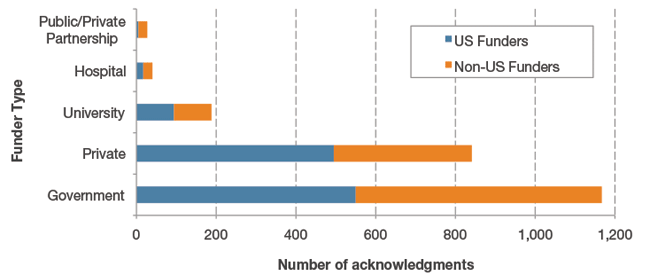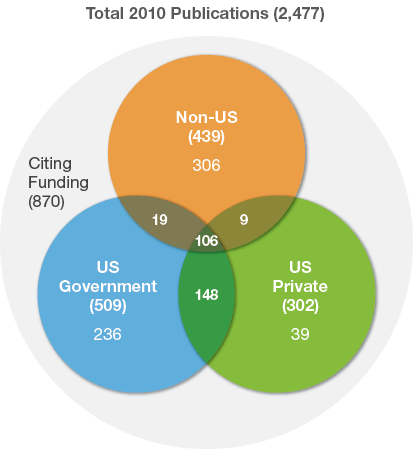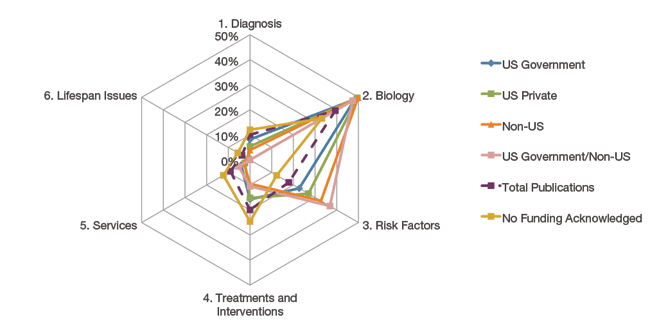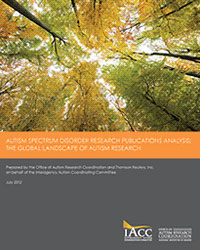Publications Analysis
Autism Spectrum Disorder Research
The Global Landscape of Autism Research
2012
The 2010 IACC Autism Spectrum Disorder Research Portfolio Analysis Report tracks US public and private autism research funding, or inputs, as shown in Figure 2.19 This chapter of the ASD Publications Analysis complements the IACC Portfolio Analysis by providing an examination of the publication activity of US and non-US funders to determine which have made significant contributions to published research, or research outputs. Acknowledged funders were identified to reveal prominent funding bodies in the autism research arena. These funding bodies were classified as either governmental or private, and the extent to which publications cited multiple sources of funding was assessed.
Who funded autism research in 2010?
To identify the organizations that sponsor autism research, the text from the funding acknowledgments sections of research publications was obtained for each publication, as available. This was achieved using a variety of strategies. The Web of Science® database includes the complete funding acknowledgment paragraphs for articles published since 2008, and MEDLINE has collected these data for publications acknowledging US NIH funding. A list of known funding organization names and aliases was also used to search the acknowledgment sections to increase the number of funders identified.
While the funding acknowledgment data in these databases are informative, it is important to understand its limitations. Different countries may have different philosophies or guidelines that influence how or when researchers acknowledge funding sources, which may result in fewer acknowledgments in some publications. Journals also have varied policies regarding the formatting and information included in the acknowledgment sections, which may affect the results of automated searches for acknowledgment data. Researchers may also simply overlook the need to acknowledge one or all of their funding sources. Despite these limitations, the funding acknowledgment data collected serve as a valuable resource for analyzing the support for many of the 2010 autism publications.
Among the 2,477 autism research articles published in 2010, 870 (36%) acknowledged a funding source. This percentage is somewhat lower than that determined in a similar analysis, which reported an average funding acknowledgment rate of 43% in all 2009 research publications indexed within Web of Science®.20 Among the 2010 autism publications, the most acknowledged funder was the US National Institutes of Health (NIH) (Table 1). NIH may receive more funding acknowledgments compared to other funders, not only because it may support more publications than other funders due to the size of its investment in autism research, but also because of the agency's requirement that grant recipients acknowledge support in all resulting research publications.v While it is likely that the overall number of publications attributed to specific funders is underreported, there is a large enough sample of acknowledged funders among the 2010 autism publications to obtain informative details about funders and their activities. Once identified, funders were manually assigned to the following five categories:vi
- Government
- Private, including non-profit and for-profit organizations
- University
- Hospital
- Public-Private Partnership
Funders were also defined by their country of origin. The complete list of acknowledged funders, categorized by funder type (e.g., Government, Private, etc.) and home country is provided in Appendix V.
2010 Funders Acknowledged on 10 or More Publications
| Rank | Funding Organization | Country | Funder Type | Publications with acknowledgment |
|---|---|---|---|---|
Rank1 |
Funding OrganizationNational Institutes of Health |
CountryUnited States |
Funder TypeGovernment |
Publications with acknowledgment437 |
Rank2 |
Funding OrganizationAutism Speaks |
CountryUnited States |
Funder TypePrivate |
Publications with acknowledgment119 |
Rank3 |
Funding OrganizationThe Medical Research Council |
CountryUnited Kingdom |
Funder TypeGovernment |
Publications with acknowledgment59 |
Rank4 |
Funding OrganizationEuropean Union |
CountryEurope |
Funder TypeGovernment |
Publications with acknowledgment38 |
Rank5 |
Funding OrganizationWellcome Trust |
CountryUnited Kingdom |
Funder TypePrivate |
Publications with acknowledgment36 |
Rank6 |
Funding OrganizationThe Canadian Institutes of Health Research |
CountryCanada |
Funder TypeGovernment |
Publications with acknowledgment35 |
Rank7 |
Funding OrganizationSimons Foundation |
CountryUnited States |
Funder TypePrivate |
Publications with acknowledgment27 |
Rank8 |
Funding OrganizationNational Science Foundation |
CountryUnited States |
Funder TypeGovernment |
Publications with acknowledgment26 |
Rank9 |
Funding OrganizationMinistry of Education, Science, Sport and Culture |
CountryJapan |
Funder TypeGovernment |
Publications with acknowledgment25 |
Rank10 |
Funding OrganizationBrain and Behavior Research Foundation/NARSAD |
CountryUnited States |
Funder TypePrivate |
Publications with acknowledgment24 |
Rank11 |
Funding OrganizationJapan Society for the Promotion of Science |
CountryJapan |
Funder TypeGovernment |
Publications with acknowledgment18 |
Rank12 |
Funding OrganizationGerman Research Foundation (DFG) |
CountryGermany |
Funder TypeGovernment |
Publications with acknowledgment17 |
Rank13 |
Funding OrganizationNetherlands Organization for Scientific Research (NWO) |
CountryNetherlands |
Funder TypeGovernment |
Publications with acknowledgment15 |
Rank14 |
Funding OrganizationNatural Sciences and Engineering Research Council |
CountryCanada |
Funder TypeGovernment |
Publications with acknowledgment14 |
Rank15 |
Funding OrganizationNational Institute for Health and Medical Research |
CountryFrance |
Funder TypeGovernment |
Publications with acknowledgment13 |
Rank15 |
Funding OrganizationMinistry of Education, University and Research |
CountryItaly |
Funder TypeGovernment |
Publications with acknowledgment13 |
Rank17 |
Funding OrganizationHoward Hughes Medical Institute |
CountryUnited States |
Funder TypePrivate |
Publications with acknowledgment12 |
Rank17 |
Funding OrganizationNancy Lurie Marks Family Foundation |
CountryUnited States |
Funder TypePrivate |
Publications with acknowledgment12 |
Rank19 |
Funding OrganizationCenters for Disease Control and Prevention |
CountryUnited States |
Funder TypeGovernment |
Publications with acknowledgment12 |
Rank19 |
Funding OrganizationFederal Ministry of Education and Research |
CountryGermany |
Funder TypeGovernment |
Publications with acknowledgment12 |
Rank19 |
Funding OrganizationFRAXA Research Foundation |
CountryUnited States |
Funder TypePrivate |
Publications with acknowledgment12 |
Rank19 |
Funding OrganizationGenome Canada |
CountryCanada |
Funder TypePrivate |
Publications with acknowledgment12 |
Rank23 |
Funding OrganizationHealth Research Board |
CountryIreland |
Funder TypeGovernment |
Publications with acknowledgment11 |
Rank23 |
Funding OrganizationNational Institute for Health Research |
CountryUnited Kingdom |
Funder TypeGovernment |
Publications with acknowledgment11 |
Rank23 |
Funding OrganizationMinistry of Health |
CountryItaly |
Funder TypeGovernment |
Publications with acknowledgment11 |
Rank23 |
Funding OrganizationThe National Health and Medical Research Council |
CountryAustralia |
Funder TypeGovernment |
Publications with acknowledgment11 |
Rank27 |
Funding OrganizationNational Science Council |
CountryTaiwan |
Funder TypeGovernment |
Publications with acknowledgment10 |
Rank27 |
Funding OrganizationSwedish Research Council |
CountrySweden |
Funder TypeGovernment |
Publications with acknowledgment10 |
Rank27 |
Funding OrganizationMinistry of Health, Labour and Welfare |
CountryJapan |
Funder TypeGovernment |
Publications with acknowledgment10 |
Rank27 |
Funding OrganizationEconomic and Social Research Council |
CountryUnited Kingdom |
Funder TypeGovernment |
Publications with acknowledgment10 |
Table 1. 2010 Funders Acknowledged on 10 or More Publications. Funders are listed along with their country of origin, their type, and the number of publications in which they are acknowledged. In cases where a single publication acknowledges multiple sources, the publication is counted for each source acknowledged.
More than 700 unique funders were represented among the 870 autism research articles published in 2010 for which funding acknowledgments could be collected. In many cases, more than one funder was acknowledged in a given article. Table 1 lists those funding organizations cited by 10 or more publications in the 2010 publication set. The most acknowledged funders were from the United States – the NIH, a Federal funding agency, with 437 acknowledgments, and Autism Speaks, a non-profit organization with 119 acknowledgments. The remaining organizations represent a mixture of non-US, governmental, and private funding organizations. Approximately two dozen of the private funding organizations were pharmaceutical companies, which received a combined 45 funding acknowledgments, representing only a small fraction of private funder acknowledgments (~5%).vii Pharmaceutical and other for-profit industries are less likely to support work that is published in peer-reviewed literature; therefore, funding acknowledgment data for these groups are limited.
Overall, the acknowledgments data indicate that ASD research was supported by a wide array of US government agencies and private foundations as well as many non-US organizations, both government and private. Figure 15 shows the distribution of funder types across all of the 2,271 funding acknowledgments in the 2010 publication set as well as the number of US and non-US funding organizations within each category. While it is not too surprising that government funding agencies were most frequently acknowledged for providing funding support, since government agencies tend to provide a large proportion of overall research funding related to health conditions and may also have strong funding acknowledgment policies, it was of interest to find that private funders were cited nearly as often. This may suggest that private funders also have strong funding acknowledgment policies or are effective in following up with funded researchers to ensure acknowledgment.
Types of US and non-US Funders Acknowledged in 2010 Autism Publications

Figure 15. Types of US and non-US Funders Acknowledged in 2010 Autism Publications. The number of funding acknowledgments is displayed by type, including Government, Private (non-profit and for-profit), University, Hospital, or Public/Private Partnership, and by their country of origin (the number of US funder acknowledgments in blue and non-US funder acknowledgments in orange). In cases where a single publication acknowledges multiple sources, each source is counted individually. Within the 870 publications with funding acknowledgment data, the total number of individual funding acknowledgments was 2,271.
Funding acknowledgments were split almost evenly between US and international funders, with US-based funders representing 51% percent of all acknowledgments (1,168 of 2,271) and being acknowledged by 64% of all publications that cited funding (560 of 870). As indicated in Table 1 and Appendix V, funding organizations from Canada, Europe, Australia, and Asia also account for substantial funding acknowledgments.
What is the extent of overlap between funding sources?
With numerous governmental and private organizations funding autism research, investigators often secure multiple sources of funding to increase their budgetary resources to support their work. To better understand these sources and extent of overlap between multiple funder types supporting the same research, the funding acknowledgments sections of autism-related journals were analyzed. Figure 16 shows the distribution of the 2010 publication funding acknowledgments among US government, US private, and non-US funding organizations as well as the number of publications shared between two (~20% of all publications) or all three funder types (~13% of all publications).ix More than 30% of the publications (282 of 870) acknowledged funding from a combination of non-US, US government, and/or private sources. These areas of intersection suggest considerable multinational and collaborative efforts related to autism research.
Overlap Between Different Types of Funders Acknowledged in 2010 Autism Publications

Figure 16. Overlap Between Different Types of Funders Acknowledged in 2010 Autism Publications. This Venn diagram represents all 2010 ASD publications that acknowledged or cited at least one funding source. The type of funding source was manually categorized into one of three groups: 1) Non-US funders (cited in 439 publications), 2) US government funders (cited in 509 publications), and 3) US private funders (cited in 302 publications).viii Areas of overlap in the diagram indicate publications that cited two or all three of the funder types. For example, in US government cited papers, 236 only cited a US government funding source, 19 publications cited the US government plus a non-US funder, 148 publications cited US government plus a US private funder, and 106 cited all three funding sources.
Do different funder types support different areas of autism research?
The Critical Question categorization scheme for publications was used to investigate whether different funder types supported different aspects of autism research. The number of publications linked to each funder type was determined, and publications were then further sorted into one of the seven Critical Question areas identified in the IACC Strategic Plan for ASD Research. Figure 17 compares the degree to which various funder types support studies in the different Critical Question research areas. The predominant pattern is similar for US government funders, US private funders, and non-US fundersx of autism research.
Patterns of Strategic Research Emphasis by Type of Funder in 2010 Autism Publications

Figure 17. Patterns of Strategic Research Emphasis by Type of Funder in 2010 Autism Publications. This graph plots the distribution of publications by Critical Question category for all 2010 publications (purple) and the type of funding those publications received, including US government (blue), US private (green), Non-US funders (orange), US government plus Non-US (pink), and publications that did not cite a funding source (gold). The patterns show that publications that received funding from both a US government and a non-US source were relatively more likely to be related to Risk Factors than the other funder types, and publications that did not acknowledge a funding source at all were more likely to fall into the categories of Treatments and Interventions, Services, and Lifespan Issues research. For figure clarity, Infrastructure and Surveillance publications are not included in this graph because the proportion of Infrastructure and Surveillance publications in all groups studied was very low.
The distribution of publications is skewed toward the basic Biology of ASD for all of these funder types, followed in order by research on Risk Factors, Treatments and Interventions, and Diagnosis. There were two deviations from this pattern. First, publications supported by international funding in the form of US government plus a non-US funding source show a somewhat higher proportion of publications in the area of Risk Factors. With few exceptions, publications with international funding also had international co-authors (described later in this report as "international collaboration"). The specific Risk Factor research publications were examined in detail and we found many to be large-scale gene discovery studies collaboratively co-authored by North American and European investigators. A second distinctive pattern of Critical Question distribution was observed in publications that did not acknowledge a funding source. A heavier concentration of these publications was associated with research in the Treatments and Interventions, Services, and Lifespan Issues Critical Question areas.
As noted above, the funding acknowledgment rate of 36% observed for 2010 publications was lower than the overall rate of 43% reported across all publications in Web of Science®.21 That same study also showed that funding acknowledgment rates in research publications can vary greatly across different research disciplines with the highest rates of funding acknowledgment – between 55% and 68% – found among publications in the natural sciences (e.g., molecular biology, chemistry, and biological sciences). In contrast, lower rates were observed in clinical medicine (32%), psychology and behavioral science (27%), and social sciences (<10%). These trends are similar to those seen among ASD publication funding acknowledgments. Specifically, in this 2010 autism publications set, articles published in education and social science fields had lower rates of funding acknowledgments than other areas. Even within the Biology and Risk Factor Critical Question areas, which had the highest rate of funding acknowledgment at 50% and 60%, respectively, a sizeable portion of the 2010 autism publications did not cite a funding source. While it is possible that research in these areas is being undertaken without formal funding support, a more likely explanation is that researchers are not acknowledging their funding sources, perhaps due to the culture of those fields or to absence of policies to require or encourage funder acknowledgment.
The absence of funding acknowledgments makes it difficult for funders to track and report progress on their investments, in turn making it more challenging for funders to demonstrate return on investment to taxpayers, donors, and investors. As productivity is often used to evaluate the effectiveness of research funding and to provide a rationale for continuing or augmenting funding levels, the inability to attribute research results to a specific funding source for such a large proportion of research publications presents potential loss of opportunities to communicate research progress and stimulate research in the autism field. Given this risk, improving the rate of acknowledgment of funding sources both in the US and internationally is an important issue that needs to be addressed to help ensure continued support and growth of the autism research field.
Although funding acknowledgment data provide a snapshot of international funding and research activity, these data have their limitations, as discussed previously. Non-US funders account for approximately half of all funders acknowledged for supporting 2010 autism research publications, suggesting that global research activity in autism is extensive. For a more comprehensive and accurate account of where autism research is taking place, author address information from the Web of Science® database was used to track global autism research publications and collaborations, which will be discussed in the next chapter.
Main findings from analysis of global autism research funders:
- 2010 ASD publications contained 2,271 funding acknowledgments to more than 700 different funders, including many government agencies and nearly as many private organizations.
- Approximately one-third of publications with funding acknowledgment data cited some combination of US government, US private, and international funding support.
- Absence of comprehensive funding acknowledgments in approximately two-thirds of ASD research publications makes it difficult for funders to track and report research progress.
- Inability of funders to comprehensively track research publications stemming from their investments may result in lost opportunities to communicate progress resulting from these investments and grow the autism field.
- Given potential risks and lost opportunities arising from a large proportion of research not providing funding acknowledgment, policymakers, funders, publishers, and institutions should encourage the research community to acknowledge research funders to ensure continued investment in ASD research.




